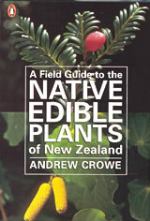|
 BOOK
REVIEWS BOOK
REVIEWS
A
Field Guide to Native Edible Plants
of New Zealand
By Andrew Crowe
Published by Godwit
Press, New Zealand, 1997
$NZ29.95
Reviewed by Mike Oates
This is one of those
enduring classics that seems to remain popular despite changing
fashions and at a time when there are plethora of books on the market
on every aspect of native plants. It has remained, like 'The Native
Trees of New Zealand' by John Salmon, a benchmark on the subject.
However, just like the most popular motor car brands, this model
needs to be repackaged to retain its popularity. The third edition
sees a change in format to a smaller pocket guide that is easy to
handle and take out in the field where it will be most useful.
The book is based on the experiences of the author whose interest
in the subject lead him to spend 10 days in the bush in February
1974 without any food supplies. This was followed with major research
leading to the latest edition which contains over 190 plants including
trees, shrubs, herbs, ferns, mushrooms, lichens, and seaweeds. Each
plant is described in detail with its major diagnostic characteristics,
the part of the plant eaten, and its major uses. It finished with
short sections on traditional cooking methods of Maori, bush survival
and poisonous plants.
This inclusion of poisonous plants is
critical to the success of the book. It is easy to mistake plants
in the wild and its important that before you eat any part of a
plant it is positively identified. The descriptive part of each
entry is therefore very important. It is pleasing to see the detailed
descriptions as well as the links to similar species that could
easily be confused. What is a little bit confusing is the double
entry of poisonous plants in both the edible and poisonous sections
of the book. Take Tutu for example. All parts of this plant are
poisonous except the flower petals. The section on this plant deals
at length with the Maori use of the plant. One must question the
detail in this section when it finishes with the advice that it
should be ignored!!
This is a small quibble though and should not detract from what
has deservedly become an enduring classic from an author who is
fast becoming one of our most prolific writers on native plants.
Also
see a later review of this book
Reviews Main Page
|


 BOOK
REVIEWS
BOOK
REVIEWS